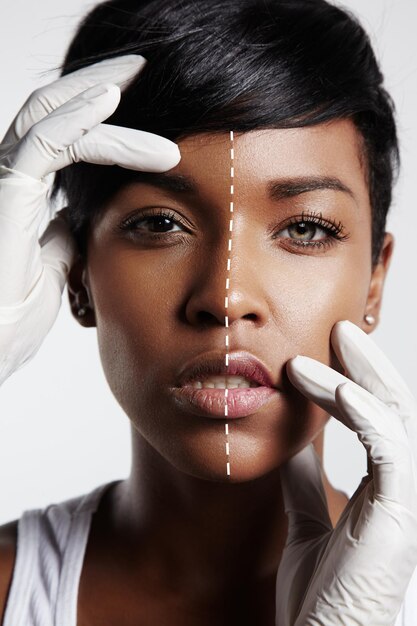This content is for informational and educational purposes only. Always consult a qualified healthcare provider.
Last Updated on February 24, 2024 by Grace Oluchi
When it comes to skin issues and care, most people usually feel the need to go see a dermatologist. But at other times they don’t know if they need an esthetician or a dermatologist.
The thing is both are skin professionals, but they have distinctive expertise and offer different kinds of services. There are times when you need an esthetician, not a dermatologist, and vice-versa.
Let’s talk about the difference between the two professions.
📋 Table of Contents
What’s An Esthetician?


Estheticians are trained professionals who focus mainly on the outmost layers of your skin. They can offer guidance with care and improvement on the outer part of your skin.
Estheticians are skin care specialists who specialize in skin and beauty care. In addition, provides general services and advice for your skin.
Unlike dermatologists, they don’t have any medical training, so they aren’t able to offer services like:
- diagnosis of skin conditions
- prescription of medications
- performing any kind of invasive treatment, which includes injectables and fillers.
However, in some states, they may be able to perform injectables and other procedures with a dermatologist present.
Here are some examples of what an esthetician can offer:
- facials
- waxing
- body scrubs, masks, and wraps
- applicator makeup, including eyebrow tinting and lash extensions
- microdermabrasion
- superficial chemical peels- they can’t perform aggressive peels that go deeper into the skin
- Their place of work is mostly at salons or day spas.
Medical Estheticians and Spa Estheticians
Estheticians can work anywhere between a regular spa, salon, and even a medical spa. Medical estheticians (sometimes called aestheticians), focus on medical care and sometimes work in a physician’s office. These professionals might offer treatments like:
Pre- and post-surgical skincare
- deeper chemical peels
- tattoo removal
- laser hair removal under a physician’s supervision
So, when you hear esthetician, just think of beauty and skin care.
How Estheticians Come About Their Career
They need a license to practice in all 50 states. To be able to attend cosmetology school, aspiring estheticians need a high school diploma or GED certificate. These programs usually last between 4 and 6 months, and require 6000 hours of training.
Program requirements depend on the state you’re in, but most of the time, they generally range from 250 to about 1000 hours of coursework.
After the completion of their training, they must take a state-approved exam to get they license. These exams include both written and practical portions- where they practice in a mannequin or volunteer model.
Now after they’ve obtained a state license, they may also choose to pursue a national certification through the National Coalition of Esthetician Association ( NCEA). This is known as the highest level of training for an esthetician.
What’s A Dermatologist?


Dermatologists are medical doctors. They specialize in diagnosing and treating skin conditions that may occur on multiple sensitive parts of the body. A Dermatologist can diagnose and treat more than 3,000 conditions.
They can:
- perform diagnostic and preventive exams
- provide treatment
- offer counseling and education about skin conditions
You May Also Read
- Cosmetic Rejuvenation Laser (CRL) Carbon Peel: Unleash Your Radiant Skin.
- The bench press muscle work: Benefits, and More.
- Fuel Your Performance: The Importance of Nutrition for Athlete
- The Price of Protection: Navigating the World of Health Insurance Costs
What can they treat?
They will typically focus on the health of your skin. Some dermatologists treat the following:
- acne
- skin lesions
- skin rashes
- hyperpigmentation
- skin cancer
- eczema and rosacea
- dermatitis
- infections
- hair loss
- problems with nails
In 2019, the CDC recorded a minimum of 44 million visits a year to the dermatologist. They don’t only improve your skin through recommendations and treatment, but they can also identify underlying health issues that show up. These anomalies showing up on your skin can be life-threatening, even though they can be treated. Like estheticians, dermatologists who specialize in cosmetic procedures can provide techniques to improve the appearance of your skin and hair.
For example, you might want to consult a cosmetic dermatologist if you’d like to reduce the appearance of wrinkles and fine lines or sunspots.
Other procedures they offer include:
- dermal fillers
- Botox
- chemical peels
- micro needling
- laser hair removal
- laser resurfacing
Any dermatologist can recommend prescription medications to treat acne, for example. However, a dermatologist who specializes in cosmetic procedures like deep peels and laser resurfacing can help you figure out other options for lessening acne scars.
With that said, all dermatologists have the ability to practice both medical and cosmetic procedures.
They can work at specialty clinics and private practices, but the ones who specialize in medical procedures mostly work for larger healthcare organizations or hospitals. While the ones who specialize in cosmetics can work at medical spas.
How dermatologist come about their career
They go through at least 12 years of education and training before practicing. Then after earning a bachelor’s degree, they:
go to med school to become a doctor
intern for a year
complete the years of residency, treating patients next to experienced dermatologists.
After that, the next step for some of them will be to continue their training and become specialists. For example, a dermatopathologist is one who diagnoses skin diseases and disorders under a microscope.
Following their residency training, they can also sit for an exam to become board-certified. A certified dermatologist has the following letters FAAO appear after their name ( fellow of the American Academy of Dermatology).
In the northern part of America, the boards that grant this certification include:
the American Board of Dermatology
the American Osteopathic Board of Dermatology
the Royal College of Physicians and Surgeons of Canada
There are other boards that also grant this certification, but these three require the highest level of training and expertise.
Dermatologist vs Esthetician ( who’s better for my skincare?)
Both deal with the cosmetic side of skin care. They can treat skin issues to make your skin better through simple procedures.
These two professionals are amazing at taking care of your skin. One isn’t better than the other. A dermatologist took a couple of steps further by adding medical advice. It just really depends on your needs at that given point in time.
A dermatologist can diagnose and treat skin issues. They can also provide recommendations to another specialist based on your needs. Just think of them as people more focused on the healthier side of your skin, not just the appearance.
Estheticians focus on the surface of your skin. They can’t diagnose or treat symptoms of skin problems. But they sure can make you look and feel better. They can provide a service to basically help prevent skin issues and improve your skin.
Need a pampering session? they got you
Need some skin-care procedures? they got you
Maintenance tips? they got you!
Estheticians are great at helping you look radiant at any given time. There are also some instances where they work under the supervision of a dermatologist.
How do I know if i need an esthetician or a dermatologist
Knowing whether to choose a dermatologist or esthetician typically comes down to your individual concerns. Both are licensed professionals who can help you with your skin care needs.
If you’re not dealing with any specific symptoms but want to work on your skin’s appearance, an esthetician can be your bestie. They can offer microdermabrasion, facials, and other superficial treatments.
However, you should keep in mind that in most states, only a dermatologist can perform more invasive treatments like dermal fillers, Botox, and scar revision surgery.
Some more distinctions to remember about a dermatologist
Laser treatments. In most states, only dermatologists are allowed to perform laser treatments. However a few states do allow estheticians to perform some laser procedures, like laser-based skin rejuvenation and laser hair removal.
Peels. Estheticians can perform mild peels like those containing alpha hydroxy acids. They can also offer moderate peels with glycolic acid in some other states. But only a dermatologist can perform deep peels that fully go into the middle layer of your skin, including peels that contain phenol or trichloroacetic acid.
Microneedling. Most states consider this service as a medical treatment, which means estheticians can’t offer it. However, in some other states, some of them working in medical places may be able to perform microneedling under the direction of a licensed physician.
In cases where you’re dealing with acne, persistent dryness, or skin discoloration, it’s best to visit a dermatologist.
They will be able to give you medications or treatments. They might also refer you to an esthetician who can offer services and help you build a skincare routine to keep things running.
How do I go about the treatment process with an esthetician and dermatologist?
Before you make an appointment with a dermatologist, make sure you check in with your insurance provider first. They will only cover your visit if you have a referral from your primary care physician (PCP). In this case, your PCP can examine your skin and refer you to a local dermatologist if need be.
If you want to find a dermatologist by yourself, you can start by checking which of them are in-network for your insurance. Also, consider your specific needs to help you find the right professional. Now, let’s say you’re dealing with severe rosacea or acne, a medical dermatologist would be the perfect fit. In the case of skin cancer or benign growth, a surgical dermatologist will be necessary.
Another helpful thing to do is to verify their board certification to be sure they’re right for you. They may have their credentials displayed on their website, but it wouldn’t hurt to do your own digging by searching the database provided by the American Academy of Dermatology or the American Board of Dermatology.
In the event of choosing to find an esthetician, you could start by asking trusted friends or family members for a recommendation.
Always make sure they’re certified to practice in your state. To be safer, you should use one that is NCEA-approved.
The bottom line
Between a dermatologist and an esthetician, one type of profession isn’t necessarily better than the other. It all boils down to the specific skin care concern you wish you address.
It’s a no-brainer to consult a dermatologist in the event of any skin conditions that may require medication or surgery. An esthetician, on the other hand, will provide surface-level solutions or a general skin maintenance guide.
Overall, what’s most important is knowing what you need and finding an accessible skin professional you can trust.

